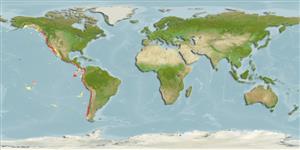Common names from other countries
Environment: milieu / climate zone / depth range / distribution range
Ecología
Pelágico; rango de profundidad 0 - 1200 m (Ref. 1982). Tropical; 4°C - 32°C (Ref. 1982), preferred 26°C (Ref. 107945); 60°N - 53°S, 169°W - 70°W
Eastern Pacific. From south of Bering Strait to Gulf of Alaska, east to Gulf of California and south to Chile. Tropical to boreal.
Length at first maturity / Tamaño / Peso / Age
Maturity: Lm 29.7 range ? - ? cm Max length : 400 cm TL macho / no sexado; (Ref. 275); common length : 80.0 cm TL macho / no sexado; (Ref. 275); peso máximo publicado: 3.0 kg (Ref. 275)
Common total length: 50 to 80 cm. Caught by jigs (Ref. 275). Maximum total length is 4 m. Common length is about 50 to 80cm (Ref. 3722). Inhabits offshore areas of continental shelves from surface to depths of at least 1200 m. Found over the shelves and near shores during feeding. Adults undergo diel vertical migrations with a night lift to the 0-200 m water layer, going down at daytime to depths of 800-1,000 m and deeper (Ref. 2130). Upper temperature limits range from 30 to 32°C in equatorial areas, while deeper water temperature limits are not less than 4 to 4.5°C. Active predator, feeds actively at dusk and dawn. Commonly feeds on copepods, hyperiid amphipods, euphausiids, pelagic shrimps and red crabs (Pleuroncodes planipes), heteropod molluscs, squid, octopods and various fish. Exhibits cannibalism, but only on juvenile squids (Ref. 1982).
Life cycle and mating behavior
Madurez | Reproducción | Puesta | Huevos | Fecundidad | Larva
Members of the class Cephalopoda are gonochoric. Male and female adults usually die shortly after spawning and brooding, respectively. Mating behavior: Males perform various displays to attract potential females for copulation. During copulation, male grasp the female and inserts the hectocotylus into the female's mantle cavity where fertilization usually occurs. Life cycle: Embryos hatch into planktonic stage and live for some time before they grow larger and take up a benthic existence as adults.
Roper, C.F.E., M.J. Sweeney and C.E. Nauen. 1984. (Ref. 275)
IUCN Red List Status (Ref. 130435)
CITES status (Ref. 108899)
Not Evaluated
Not Evaluated
Human uses
Pesquerías: comercial
FAO - pesquerías: landings, species profile | FishSource | Sea Around Us
Herramientas
Fuentes de Internet
Estimates based on models
Preferred temperature
(Ref.
115969): 7.8 - 13.8, mean 10.8 (based on 88 cells).
Resiliencia
Alto, población duplicada en un tiempo mínimo inferior a 15 meses (K=0.17-1.2; tm=0.53).
Prior r = 1.19, 95% CL = 0.79 - 1.79, Based on 2 data-limited stock assessments.
Vulnerability
Very high vulnerability (90 of 100).
